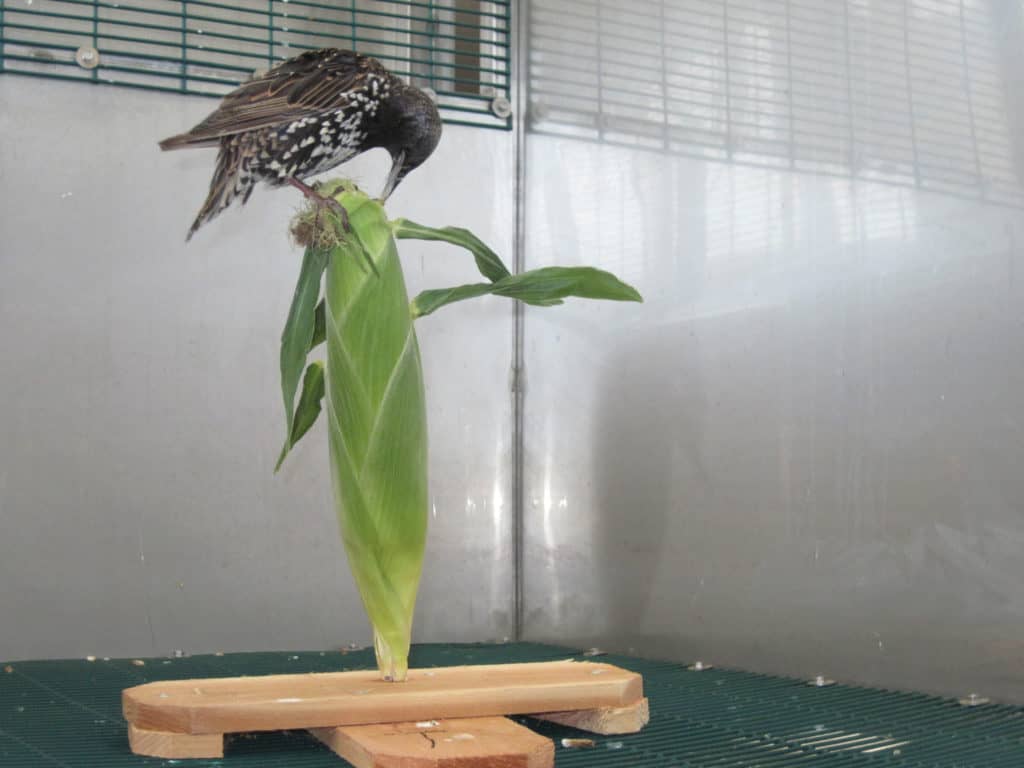Share this article
Birds don’t always like what they see
Each spring, an estimated 52 million blackbirds migrate north into the northern Great Plains of the United States. In the fall these birds and their offspring, totaling 75 million, drift southward feeding on sunflower, corn, rice and other grain crops, costing farmers millions of dollars.
Scientists at the USDA-Wildlife Services’ National Wildlife Research Center have long-standing partnerships with private companies and industry groups to investigate nonlethal bird and rodent repellent compounds, formulations, and application strategies for reducing wildlife damage. One such partnership with Arkion Life Sciences has resulted in a new repellent strategy and a suite of nonlethal repellent products that use a naturally-occurring compound called anthraquinone, or AQ.
AQ was first patented as a bird repellent in 1944 to reduce bird damage to agricultural crops. At that time, the assumed mode of action was post-ingestive stress (an unpleasant sickness in the birds that eat it). Recent NWRC-Arkion research has shown that AQ can also cause avoidance behaviors in birds through visual cues related to the compound’s absorption of the ultraviolet (UV) spectrum.
“Birds don’t always like what they see,” states NWRC research wildlife biologist Dr. Scott Werner. “Our studies with captive blackbirds have shown that the birds rely on visual cues to avoid foods previously paired with a negative consequence. We’ve been able to take advantage of those visual cues to design repellent products and application strategies that cause pest birds and some mammals to avoid treated food items or deter them from sitting or perching on treated structures.”
NWRC research has also shown that if birds first come into contact with AQ, other less expensive compounds with similar UV spectral characteristics can be included in AQ formulations such that the effective concentration of AQ can be considerably reduced.
The results of the NWRC-Arkion partnership not only help to protect against crop depredation and disease, but this research also benefits wildlife conservation in the U.S. and food production in lesser developed countries. For example, AQ-based rice seed treatments significantly reduce blackbird and grackle damage to newly planted rice, and foliar applications to emergent soybeans reduce damage caused by grazing geese. Applications made to perch sites on the outside of poultry facilities cause wild birds to avoid those areas, thereby reducing the threat of wild birds transmitting diseases to domestic poultry flocks.
An AQ-based product used as a seed treatment on upper Midwest corn crops has significantly reduced sandhill crane damage to newly-planted corn seed, reducing the need to lethally remove cranes. The corn application has been so successful that its product label was recently expanded for use in all 50 states. Arkion has also obtained a product registration in the Republic of Ghana for its AQ-based repellent for newly-planted and ripening rice. According to Arkion, initial field trials on Ghana rice have doubled its yield, representing changes from subsistence to cash crop farming and allowing children to go to school rather than scaring birds away from rice fields.
Future NWRC-Arkion research efforts are focused to further develop AQ-based repellents for wild birds and wild rodents for the protection of plant and animal agriculture. Applications of this repellent technology are expected to increase throughout the U.S. and internationally, saving farmers money and helping to protect a wide variety of resources. For more information, please visit the NWRC Repellent Project webpage.

A European starling samples an ear of corn treated with Arkion’s AQ-based bird repellent product. ©USDA Wildlife Services

Human-visible (top) and ultraviolet images (bottom) of the UV-absorbent feeding cue (left) and the UV-reflective feeding cue used to test conditioned food avoidance among red-winged blackbirds at USDA-Wildlife Services’ National Wildlife Research Center. USDA solely owns one patent, co-owns one patent, and co-owns three patent applications for AQ technologies with Arkion Life Sciences. ©USDA Wildlife Services
Header Image: Rice is a major food staple for Ghana and 85% of its rice is grown in small, 5 to 7-acre plots. Initial repellent field trials on Ghana rice have doubled its yield, representing changes from subsistence to cash crop farming. ©Wikimedia Commons









